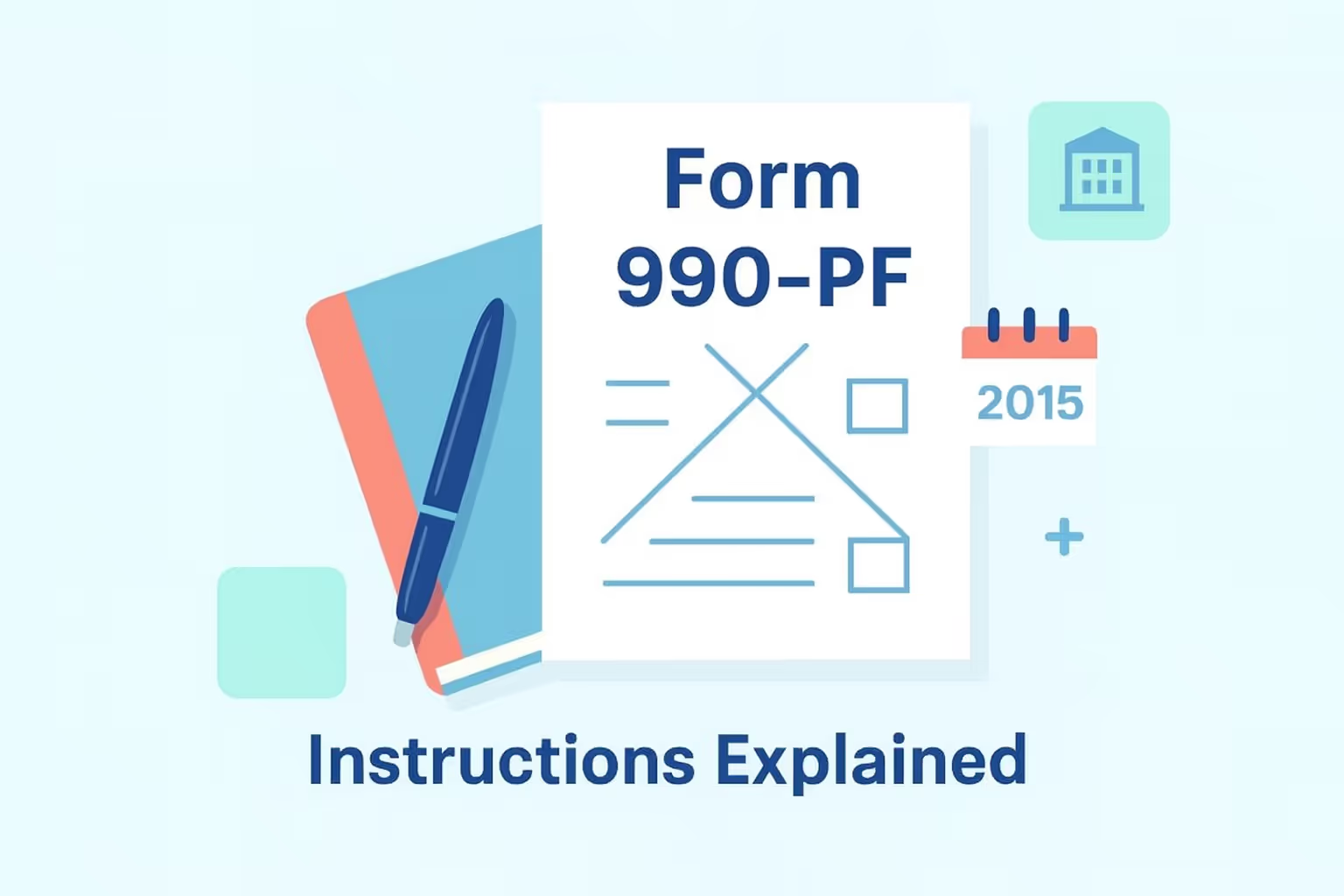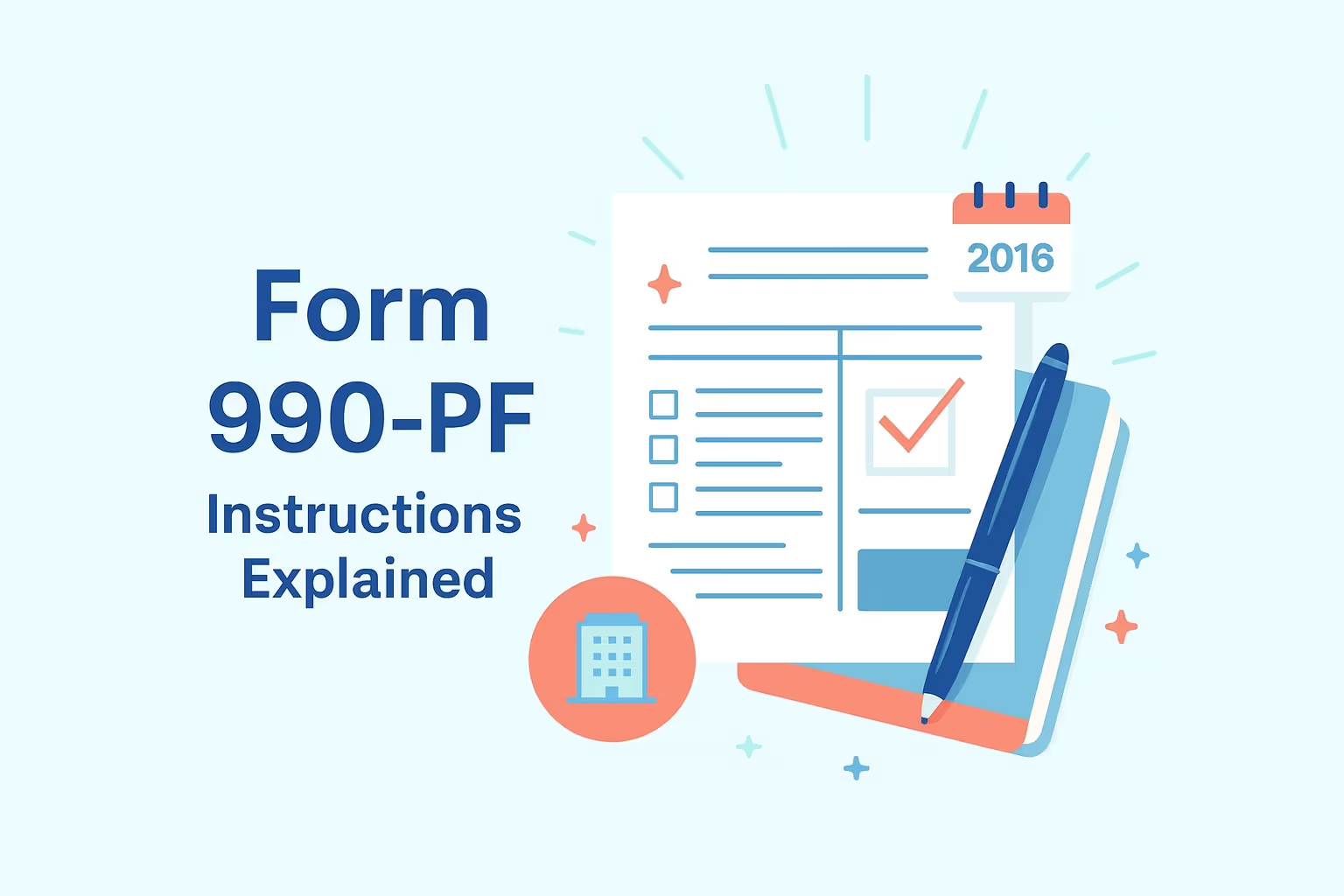Form 990-PF 2014 Instructions: How Private Foundations File
Form 990-PF serves as the annual tax return required under the Internal Revenue Code for exempt private foundations, taxable private foundations, and nonexempt charitable trusts treated as private foundations. Each filing organization must report income, adjusted net income, and net investment income to determine the excise tax based on investment earnings. Each organization must complete its reporting to support compliance and preserve its tax-exempt status with the IRS.
Private foundations use the form to provide a complete financial overview, including net assets, net income, capital gain, and charitable distributions. The return confirms the foundation’s charitable purposes, documents its related expenses, and discloses details about financial accounts. Organizations that claim private foundation status or have previously held public charity status are required to file Form 990-PF to maintain transparency about their operations and funding sources.
Timely filing allows the IRS to verify reported figures and confirm ongoing eligibility as a tax-exempt entity. The due date generally falls on the fifteenth day of the fifth month following the close of the accounting period. The 2014 Form 990-PF outlines that foundations must file on time and include all required schedules to maintain good standing and prevent errors in filing.
Understanding Private Foundations
Private foundations play an essential role in charitable giving under the Internal Revenue Code. These organizations are usually funded by a single donor, family, or corporation and operate to advance their missions through grants and direct programs. Each foundation must meet annual reporting requirements to demonstrate transparency in income, fund balances, and charitable distributions. Knowing each foundation’s structure ensures proper compliance with Form 990-PF 2014 Instructions.
Definition and Structure
- A private foundation is a tax-exempt entity organized for charitable, educational, or scientific purposes and must report its income and adjusted net income each year to remain compliant.
- A private operating foundation primarily conducts its own charitable programs and allocates most of its resources to direct activities instead of grantmaking.
- A non-operating foundation focuses on grantmaking by distributing funds to other qualifying charities, supporting organizations, or approved recipients.
- A nonexempt charitable trust treated as a private foundation functions under similar reporting rules but lacks a formal exemption and must confirm excise tax-based obligations annually.
- A foreign foundation that operates or holds assets within the United States must comply with U.S. filing requirements and disclose its financial activity.
Key Responsibilities
- Every exempt private foundation must file its returns promptly to maintain its tax-exempt status and prevent the accumulation of unpaid taxes or excise liabilities.
- Foundations must report precise figures for net investment income, capital gain net income, and related expenses to ensure transparency and accountability.
- Charitable distributions must be reported to demonstrate fulfillment of qualifying distribution requirements and alignment with the foundation’s charitable purposes.
- Foundation managers must oversee compliance with federal income tax reporting standards and maintain transparency in governance.
- All financial disclosures and operational reporting must comply with the Internal Revenue Code, including information on program-related investments and professional fees.
Maintaining Compliance
- Maintaining detailed records for financial accounts, donor restrictions, and fund balances supports accuracy and readiness for IRS review.
- Foundations strengthen credibility by verifying that figures for net assets, net income, and unrelated business income match official records.
- Confirming that all activities align with charitable objectives and exclude prohibited tax shelter transactions preserves organizational integrity.
Private foundations that adhere to these standards strengthen public trust and maintain their exempt status while fulfilling their charitable commitments. Consistent adherence to reporting rules supports long-term operational stability. Ongoing compliance enables each organization to fulfill its charitable mission effectively.
Filing Requirements for Tax Year 2014
Private foundations are required to meet specific filing obligations to maintain their tax-exempt status under the Internal Revenue Code. The Form 990-PF 2014 Instructions outline how each filing organization should report its income, expenses, and charitable distributions. Understanding which entities must file and how to prepare an accurate return ensures compliance and preserves federal recognition.
Entities Required to File
Exempt private foundations are required to file Form 990-PF annually, regardless of their financial activity. Taxable private foundations are also required to submit returns that document income tax and excise tax based on their net investment income. Nonexempt charitable trusts treated as private foundations must file the form to verify charitable activities and report income and related expenses.
Organizations that claim private foundation status, even if their exemption applications remain pending, must complete the form. Former public charities reclassified as private foundations must also file to demonstrate compliance with adjusted net income calculations and distribution requirements. Foreign foundations operating or maintaining financial accounts within the United States must meet these same reporting standards.
Filing Deadlines and Timeliness
Private foundations must file promptly to avoid interest or additional charges on unpaid tax amounts. The due date is the fifteenth day of the fifth month after the close of the organization’s accounting period. A foundation operating on a calendar year must submit its return by May 15 of the year following the calendar year.
If the due date falls on a legal holiday or weekend, the foundation may file on the next business day without penalty. Timely filing ensures the IRS can assess excise tax obligations, verify financial accounts, and confirm continued eligibility as a tax-exempt entity. If a foundation files late or submits incomplete information, the IRS may issue correspondence or assessments that require corrective action.
Electronic and Paper Filing Options
Organizations filing 250 or more returns during the calendar year are required to submit Form 990-PF electronically. This total includes all federal returns, such as income tax, employment tax, and information returns, as well as all other applicable federal taxes. Electronic submission supports accuracy, faster processing, and verified receipt from the IRS.
Smaller foundations may still choose to e-file voluntarily or mail paper returns. Each return must include signatures from foundation managers, required schedules, and supporting statements for adjustments to fund balances. Consistency across previously filed returns is necessary to ensure accurate carryovers of undistributed income and other adjustments.
The About Form 990-PF page on the IRS website outlines who is required to file, the form’s purpose, and where to access the current versions. The resource also clarifies how organizations can confirm their filing category and determine whether they meet thresholds for electronic submission.
Private foundations that meet filing deadlines, include all required sections, and provide accurate data maintain compliance and strengthen their credibility. Consistent reporting helps prevent errors in future filings and demonstrates a commitment to transparency and accountability. Careful adherence to Form 990-PF 2014 requirements supports accountability while reinforcing public trust in charitable operations.
Reporting Financial Information
Private foundations must report all financial data with precision to maintain compliance and uphold transparency. Each filing organization must disclose details about income, expenses, and fund balances to verify adherence to the Internal Revenue Code. Accurate reporting on Form 990-PF, as outlined in the 2014 Instructions, enables the IRS to calculate excise tax correctly and supports the foundation’s tax-exempt status.
Reporting Requirements and Income Categories
Foundations must complete Part I of Form 990-PF to report income and related expenses. The section captures gross receipts, interest income, dividends, and capital gain net income. Properly categorizing income prevents misreporting and helps the IRS determine adjusted net income and taxable income components.
Reporting requirements extend to unrelated business income, which is subject to federal income tax when derived from non-charitable activities. Each foundation must also disclose income from foreign organizations, foreign bank accounts, and program-related investments. Accurate reporting of each source enhances compliance with excise tax-based obligations and prevents issues related to undistributed income.
Expense reporting should include both direct and indirect costs, such as professional fees, administrative expenses, and investment management fees. Transparency in fund allocations helps demonstrate that expenditures support charitable purposes rather than personal or non-qualified activities.
- Each foundation must report gross receipts from all revenue-generating activities to disclose the total amount collected during the reporting period.
- The organization must include interest income earned on deposits, securities, or loans as part of its investment-related earnings.
- Capital gains and capital gain net income from asset sales must be reported to reflect profits derived from the sale or exchange of capital assets.
- Unrelated business income must be reported because it is subject to federal income tax when generated through non-charitable operations.
- The return must include related expenses tied to grantmaking and program operations to demonstrate that expenditures further the foundation’s charitable objectives.
- Each filing organization must list investment management fees and professional service charges to ensure transparency in fund administration.
Net Assets, Net Income, and Accounting Method
Part II of Form 990-PF requires reporting of assets, liabilities, and fund balances at the beginning and end of the year. Each foundation must calculate net assets to reflect its financial position and reconcile changes with prior returns.
Net income represents total revenue minus allowable expenses and adjustments, including capital gains, interest, and other investment income. The foundation must use one accounting method; it may choose either the cash method or the accrual method and apply it consistently across all filings to ensure accuracy and comparability.
Consistent accounting allows the IRS to confirm that income and expenses align with reported activities. Errors may affect payout calculations or excise tax assessments. Foundations should review records thoroughly before submission to verify compliance.
Documentation, Disclosures, and Accuracy
Supporting documentation verifies the reported figures and provides evidence for all transactions, including donor restrictions, grants, and program-related investments. Complete records help explain variances and confirm accurate reporting.
Foundations with foreign operations must disclose foreign foundations or bank accounts to comply with U.S. tax laws. Maintaining detailed records for financial accounts, valuations, and professional services demonstrates accountability and transparency, fostering trust and confidence in the organization.
Accurate classification of revenue, fund balances, and expenses strengthens financial integrity and supports compliance. Consistency across reporting periods builds trust and confirms sound governance.
Tax Liability and Estimated Tax Rules
Private foundations are required to calculate and pay taxes on investment earnings to meet federal compliance standards under the Internal Revenue Code. The excise tax based on net investment income supports IRS oversight and ensures foundations contribute appropriately to federal revenue. Understanding how to determine excise tax obligations and meet estimated payment requirements helps each filing organization remain compliant with federal requirements.
Excise Tax Based on Net Investment Income
The excise tax is assessed on a foundation’s net investment income, which includes dividends, interest income, rents, royalties, and capital gains. The standard rate is 2%, though certain qualifying foundations may reduce the rate to 1% when they meet specific charitable distribution thresholds. This calculation requires precise reporting of income, related expenses, and adjustments to ensure accuracy across the tax return.
Foundations must include all capital gain net income and related expenses associated with the production of investment income. Each organization should verify the treatment of unrelated business income and adjusted net income when determining overall tax liability. Filing organizations with foreign accounts, foreign foundations, or program-related investments must disclose these activities for complete transparency.
Estimated Tax Obligations
Private foundations expecting to owe $500 or more in excise tax must make quarterly estimated tax payments. The IRS requires consistent payments throughout the year to prevent the accumulation of unpaid tax and interest. Each installment must reflect current-year activity, including changes in gross receipts, investment income, and fund balances.
Estimated taxes are based on projected net investment income and must account for income tax and excise tax liabilities. Organizations must review prior returns to identify carryovers, undistributed income, and any adjustments affecting the current year’s obligations. Proper planning reduces the risk of discrepancies in future filings and ensures full compliance with federal income tax requirements.
Payment Methods
- Electronic Federal Tax Payment System (EFTPS): Secure online system allowing users to schedule and confirm federal tax payments. The Electronic Federal Tax Payment System (EFTPS) page explains enrollment procedures and scheduling features.
- Electronic Funds Withdrawal: Direct payment from a checking or savings account during e-filing.
- Check or Money Order: Payable to the “United States Treasury,” accompanied by Form 990-PF and identifying details.
Foundations must track all transactions and retain proof of payments for future verification. Reconciliation between financial accounts and reported amounts ensures consistency and reduces the likelihood of errors in the filing process.
Private foundations that calculate taxes accurately, pay taxes on time, and maintain records of estimated payments demonstrate accountability and financial discipline. Effective management of excise tax obligations fosters transparency, supporting ongoing eligibility for tax-exempt status.
Governance, Management, and Key Personnel
Private foundations must identify and report individuals responsible for overseeing operations, approving grants, and managing assets. Clear disclosure of governance details demonstrates compliance with the Internal Revenue Code and reinforces the foundation’s commitment to transparency. Each filing organization must include accurate information about leadership roles, compensation, and any transactions involving foundation managers or disqualified persons.
- Foundation Managers: Foundation managers include directors, officers, and trustees who exercise substantial authority over the foundation’s operations. Each person must be listed with their title, average weekly hours, and compensation. Reporting their responsibilities ensures the IRS can assess alignment between managerial duties and charitable objectives.
- Highly Paid Employees: Employees whose compensation exceeds reporting thresholds must be included in Part VIII of Form 990-PF. Compensation includes salaries, bonuses, and additional benefits such as retirement contributions or expense allowances. Accurate reporting confirms that compensation arrangements remain reasonable and consistent with the foundation’s charitable purposes.
- Disqualified Persons: Disqualified persons include substantial contributors, family members, and certain business partners with financial influence over the foundation. Transactions involving these individuals, such as loans, grants, or property exchanges, must be disclosed and comply with self-dealing prohibitions under the Internal Revenue Code. Transparency helps prevent conflicts of interest that could jeopardize tax-exempt status.
- Compensation and Related Expenses: Compensation must reflect fair market value for services provided to the foundation. Related expenses, including reimbursements and allowances, require detailed reporting to ensure they support legitimate business purposes. Foundations should maintain written policies governing approval processes and reimbursement documentation.
- Governance Policies: Written governance policies outline procedures for conflicts of interest, record retention, and grantmaking oversight. Adopting and enforcing these policies promotes ethical conduct and consistent compliance with applicable regulations. Regular board reviews ensure internal controls remain current and effective.
- Recordkeeping Practices: Foundations must maintain board meeting minutes, employment contracts, and supporting schedules for a minimum of four years after the date of filing. These records serve as evidence of compliance during audits and confirm that financial decisions align with the organization’s charitable mission.
Complete disclosure of governance information strengthens accountability and fosters public trust. Foundations that maintain strong management oversight and transparent practices demonstrate a lasting commitment to integrity and compliance within the charitable sector.
Compliance and Exempt Organization Standards
Private foundations must comply with federal reporting requirements to preserve their tax-exempt status. The Internal Revenue Code requires consistent oversight of financial accounts, charitable distributions, and related expenses. Adhering to these requirements confirms the foundation’s commitment to public accountability and effective stewardship of charitable resources.
Foundations must demonstrate annual compliance by filing their reports promptly, providing complete and accurate information, and adhering to all operational restrictions. Failure to meet distribution requirements or disclose related transactions can impact tax-exempt status and lead to excise tax-based adjustments. Accurate reporting of income tax liabilities, net investment income, and qualifying distribution totals helps align activities with federal standards.
- Minimum Distribution Requirements: Non-operating foundations must distribute at least 5% of the average fair market value of non-charitable-use assets annually. Meeting this threshold prevents undistributed income from accumulating and ensures continuous support for charitable programs.
- Self-Dealing Restrictions: Transactions between the foundation and disqualified persons, such as substantial contributors or family members, are strictly prohibited. All grants, leases, or exchanges must serve the organization’s charitable purposes.
- Excess Business Holdings: Ownership interests in for-profit enterprises are limited under the Internal Revenue Code. Compliance helps prevent conflicts of interest and preserves independence from private benefit.
- Taxable Expenditures: Spending that does not further the foundation’s charitable mission, such as lobbying or specific grants to individuals, may trigger excise tax assessments. Review all disbursements to confirm alignment with approved purposes.
- Recordkeeping Obligations: Retain documentation supporting each charitable distribution, including grantee reports and evidence of expenditure responsibility. Maintain financial records for at least four years after filing to satisfy IRS audit standards.
Foundations must also document donor restrictions, related investments, and any amendments to governing instruments. Detailed disclosures promote transparency and enable the IRS to verify that each activity aligns with the foundation’s charitable objectives. Regular internal reviews ensure that grantmaking, investment policies, and governance procedures remain compliant with evolving federal regulations.
Ongoing education for foundation managers strengthens their understanding of operational standards. Periodic policy updates and independent evaluations further reinforce accountability. Consistent compliance safeguards the organization’s exempt status while maintaining public confidence in its commitment to lawful and effective charitable activity.
Diligent adherence to reporting, distribution, and operational standards supports the long-term integrity of every private foundation. Compliance affirms that resources are used solely for approved charitable purposes, fulfilling both regulatory and ethical obligations.
Common Filing Mistakes and How to Avoid Them
Filing Form 990-PF requires precision and a thorough understanding of technical reporting standards. Many organizations encounter errors due to incomplete data, inaccurate carryovers, or inconsistent accounting practices. Recognizing these issues allows private foundations to strengthen compliance with the Internal Revenue Code and maintain their tax-exempt status.
- Filing Deadline
- Common Mistake: Missing the submission date or not accounting for a legal holiday, leading to late filing penalties.
- How to Avoid the Error: Mark the 15th day of the fifth month after the fiscal year ends and adjust for legal holidays to ensure on-time filing.
- Financial Consistency
- Common Mistake: Reporting inconsistent net assets, net income, or adjusted net income across filings.
- How to Avoid the Error: Reconcile prior returns and confirm all figures match verified fund balances and accounting records.
- Accounting Method
- Common Mistake: Switching between cash and accrual methods when recording income or expenses.
- How to Avoid the Error: Use one accounting method consistently across all years to avoid discrepancies.
- Incomplete Sections
- Common Mistake: Leaving out required parts (e.g., Part VIII on foundation managers or Schedule B for substantial contributors).
- How to Avoid the Error: Review all sections before submission and verify all schedules and attachments are included.
- Foreign Disclosures
- Common Mistake: Omitting disclosures on foreign accounts, foreign organizations, or foreign foundations.
- How to Avoid the Error: Report all foreign transactions and keep supporting documentation for cross-border grants or investments.
- Carryover Reporting
- Common Mistake: Failing to include prior-year carryovers of undistributed income that affect payout calculations.
- How to Avoid the Error: Track undistributed income every year and ensure carryovers are included in current filings.
- Expense Classification
- Common Mistake: Misclassifying personal or unrelated costs as professional fees or program expenses.
- How to Avoid the Error: Keep separate records for personal and charitable expenses, and maintain detailed documentation for each cost.
Accurate preparation requires verifying income tax, excise tax, and qualifying distribution totals against financial accounts. Retaining records for donor restrictions, program-related investments, and capital gains enhances transparency and accountability. Conducting an internal review before submission ensures compliance with the Internal Revenue Code and promotes confidence in each filing organization’s operations.
Frequently Asked Questions
How can private foundations file promptly to maintain compliance?
Private foundations must file their returns promptly to maintain their exempt status and avoid added charges for unpaid taxes. The IRS requires submission of Form 990-PF by the fifteenth day of the fifth month after the accounting period closes. Filing electronically helps confirm receipt and prevents processing delays. Consistent timeliness demonstrates accountability under related regulations and ensures the foundation remains in good standing with federal compliance requirements.
What steps ensure accurate reporting of undistributed income?
Foundations must calculate undistributed income based on qualifying distribution requirements and report carryovers in each filing year. Accurate documentation of prior payouts helps prevent overstatement or understatement of obligations. When undistributed income remains, it should be distributed within the timeframe defined by the IRS. Proper accounting and recordkeeping confirm that charitable funds are used appropriately and help preserve the organization’s compliance with annual distribution standards.
How does a private foundation maintain exempt status under federal law?
A foundation maintains exempt status through accurate reporting, proper governance, and consistent adherence to charitable purposes. It must avoid self-dealing, unrelated investments, or activities that conflict with its mission. All transactions involving such persons, including substantial contributors or foundation managers, must comply with the Internal Revenue Code. Transparent reporting and documented oversight safeguard the organization’s federal recognition as a tax-exempt charitable entity.
What are the responsibilities of foundation managers when overseeing financial operations?
Foundation managers oversee charitable programs, grant approvals, and compliance with federal requirements. They must verify financial accuracy, ensure charitable distributions align with the mission, and prevent transactions involving disqualified persons. Proper documentation supports accountability in cases of audits or reviews. Active oversight from foundation managers also ensures adherence to related regulations and maintains confidence in the organization’s management practices and financial integrity.
How should a foundation report charitable distributions each year?
A foundation must report charitable distributions in detail, identifying recipients, amounts, and qualifying purposes. Each transaction should be documented with supporting evidence, such as grant agreements and expenditure reports, to ensure transparency and accountability. These records confirm that funds further the foundation’s exempt purposes. Accurate reporting reinforces compliance, validates charitable intent, and ensures continued eligibility for federal benefits associated with tax-exempt operations.
What deductions or expenses may affect taxable income calculations?
Foundations may deduct mortgage interest, investment advisory costs, and certain administrative expenses directly related to their charitable purpose. Expenditures such as an excess parachute payment or unrelated compensation may trigger a review or additional assessment. Maintaining proper categorization of tax paid and deductible costs ensures accuracy in calculating annual liabilities. Expense documentation and classification must align with the Internal Revenue Code to ensure transparent reporting.
What are the reporting rules for foreign activities and complete liquidation?
A foundation conducting activities in a foreign country must disclose transactions, grant payments, and partnerships in accordance with related regulations. Any complete liquidation, reorganization, or asset transfer must be reported to the IRS to verify continuation of the charitable mission. These disclosures provide transparency into global operations and confirm that all distributed funds and property remain consistent with the organization’s exempt objectives and compliance obligations.




























